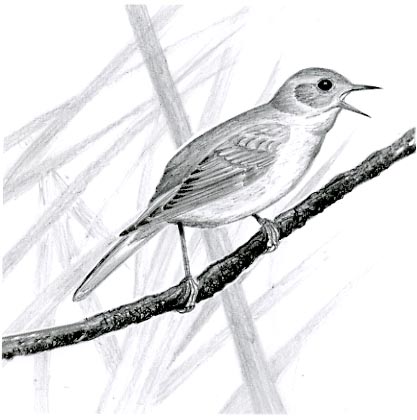
Dear Bird Folks,
I have lived on Nightingale Pond Rd. for nearly ten years and I have never seen or even heard a Nightingale. What gives? You would think in all that time I would have seen at least one. What do I need to do to see a Nightingale?
-Leslie, Bourne, MA
I can help you Leslie,
It shouldn’t be too hard for you to find a Nightingale if you follow my instructions. On the third week in May, on the first clear evening, go outside between 9:30 and midnight. Step away from the bright lights of your house and carefully make your way to your car. Quietly open your car door and slip inside, gently closing the door behind you. Making sure the radio is turned off, start your engine and slowly back out of the driveway. Once you are on the road, put on your high-beams and gradually creep down the road. With your eyes peeled, keep on the lookout for the signs. If you are careful, and of course lucky, you will soon see the signs. The signs I’m referring to should say “Rt. 25, north to Boston.” Speed up your car and jump on Rt. 25 and follow the signs to Boston and then to Logan Airport. Take the first available flight to England and there you will find all of the nightingales you want. See? I told you I could help.
I find the name of your road a bit odd Leslie. Usually when they name a street or subdivision after a particular species of wildlife, it’s because that’s the species that has been displaced by the development. Whether it be, “Bobwhite Way,” or “Badger Boulevard,” “Alligator Alley,” those are the names of the creatures that used to live there, before the bulldozers moved in. However, this is not the case with Nightingale Pond Road. Nightingales are not naturally found in North America. I’m not sure who chose the name, but I’d bet it was either a homesick Brit, a person named Gale or just some guy who was out of ideas. Whatever the reason, it is not named for a bird that you’ll ever see in the wild, unless you take a long plane ride across the Atlantic.
Nightingales are a bird that most of us are familiar with, but in reality we have no clue what they look like. Many times I suggest everyone stop what they are doing, run and grab a bird book and look up a particular bird’s picture. People who actually check out the bird are surprised at how visually striking some birds can be. Well, you can leave your books on the shelf kids, because when it comes to good looks, the nightingale has nothing going for it, even by British standards.
Nightingales are ordinary appearing, slender brown birds, looking very much like a skinny sparrow or a thrush. In fact, it was long thought that Nightingales were a member of the thrush family, but in recent times they have been considered to be closer to the Old World Flycatchers. (I’ll bet you’re thrilled to know that little piece of information.) What separates a Nightingale from other ordinary looking brown birds is its song, which it may sing day or night. Its song is a loud array of notes, that includes many whistles and trills. To my ears it sounds much like the yapping of our mockingbird, but to the many British writers and poets, the Nightingale’s song emotes a vast spectrum of emotions, ranging from joy and love, to melancholy and despair. The Nightingale’s song was immortalized by both Keats and Shakespeare, whoever they were.
The Nightingale’s song is so well thought of throughout the world that the bird’s name is used as an adjective to describe a quality singer. Many Cape Codders are familiar with the Jenny Lind Tower in North Truro. Jenny Lind was a famous 19th century Swedish opera diva who was commonly referred to as the “Swedish Nightingale.” Don’t ask me how a Swedish opera singer ended up with a tower in Truro, but I do know that her nickname, Swedish Nightingale, is a bit of a mistake. In the world of birds, only the male Nightingales sing. So either her nickname was given in error or there is more to Jenny’s story than we know.
The Nightingale is often thought of as a British bird, but they are found throughout most of southern Europe during the summer and spend their winters enjoying southern Africa. In recent years their population has been dropping with no clear explanation as to why, but I’m sure development has something to do with it.
If you truly want to see a Nightingale, Leslie, you should get out of Bourne, MA, and get over to Bourne, England. But don’t wait too long. You never know when somebody will decide it’s time to build a Nightingale Road over there.